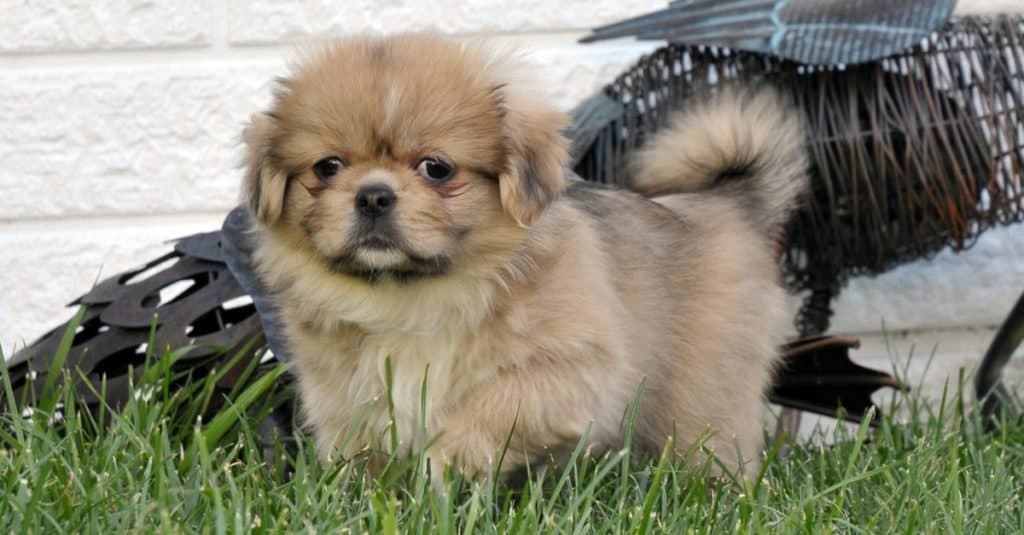The Tibetan Spaniel is a joyful, affectionate dog type that also makes an ideal companion animal. If you’re looking to bring a canine into your life, and are unsure of the breed you’d like, consider this breed. Some Tibetan Spaniel facts might warm you up to these cuddly creatures.
While adorable and sure to bring comfort to your life, the canines, like any breed, also have health issues. Be aware of these before adopting your furry friend, so you know how to best support them in their times of need.
The Tibetan Spaniel

Tibetan Spaniels have a protective double coat.
©Flickr – License
The Tibetan Spaniel is a small and intelligent dog that humans in Tibet first bred. The canine has a small, domed head and short, blunt muzzle. In addition, some wrinkling behind the nose on the muzzle is common. The eyes and nose are both black. The eyes are also set wide apart and are a medium oval shape. There is no extra-skin around the eyes of the Tibetan Spaniel.
The ears flop down next to the head and can extend down to the cheek. Plus, they are feathered in a v shape. The neck is also covered in a mane of hair. Tibetan Spaniels have bowed front legs and “hare-like” feet. The canine’s tail is feathered, fluffy, sits high and atop their back.
Tibetan Spaniels also have a glossy double coat that lays flat against its skin in most places. In addition, the coat will be medium in length. Colors can range from solid, shaded, and multi-colored. Breeders also note shades of red, fawn, gold, white, cream, black, tan, and parti. The feet will most likely be white. The breed grows to be about 10 in at the shoulder and weighs between nine and 15 pounds.
Common Facts
These seven Tibetan Spaniel facts might surprise you and leave you wanting to adopt one for yourself.
#1 They aren’t Technically Spaniels

The Tibetan Spaniel bonds closely with its owner.
©Flickr – License
Humans bred spaniels as gun dogs, which means they assist hunters in finding and retrieving game. These breeds can handle the loud noises of firearms while skillfully locating game.
Unlike other spaniels, the Tibetan Spaniel is not a gun dog. The breed is a companion dog and would not be able to assist during hunting. The misnomer could come from the French word “epagnuel” which referred to a companion dog and comfort favored by folks in the royal courts. It could also come from their resemblance to lapdog versions of hunting spaniels.
#2 They were Bred for Buddhist Monasteries

Tibetan Spaniels have medium length coats.
©BIGANDT.COM/Shutterstock.com
The Tibetan Spaniel came to being in Buddhist Monasteries. To this day, they serve alongside monks, lamas, and Tibetan Mastiffs in monasteries. The spaniels laid in bed with monks and lamas, keeping them warm during the freezing winters. The breed is thought to come from small monastery dogs and are quite loyal to their chosen Lama.
#3 The Tibetan Spaniel has Multiple Names

Tibetan Spaniels will adapt to their owner’s level of activity.
©Erik Lam/Shutterstock.com
The Tibetan Spaniel is a dog with many names, depending on who you’re talking to. Within the monasteries, monks called them “Little Lions”. The breed looks like the Snow Lion, which is a Tibetan celestial animal. The symbolism gave the animal great value, though they were not sold.
If traveling to Tibet, you’ll want to call the dog Simkhyi. The word means housedog, room dog, or bedroom dog. In English speaking places, the Tibetan Spaniel is sometimes called the Tibbie. Affectionate breed owners will use the nickname in most cases, rather than the official name of the animal.
#4 Some Appear in Ancient Art

The Tibetan Spaniels come in a variety of colors.
©Lambos Pavlides/Shutterstock.com
Researchers noticed that Tibetan Spaniels appear in art dating back to 1100 B.C., which makes the breed at least 3,000 years old. Some people suppose that this makes the Tibetan Spaniel the ancestor of the Pekingese and the Lhasa Apso.
#5 They were the Perfect Gift

The dogs have rounded, fluffy tails.
©navatu/Shutterstock.com
In history, Tibetan Spaniels did not go for prices. Monks instead gifted the animals to leaders in Buddhist countries. From there (according to some sources), the royals crossbred the tibbies with their pugs to create the Pekingese. Other sources state that Lamas received Pekingese as gifts from royals and crossed them with Lhasa Apsos to make the Tibetan Spaniel.
#6 The Dogs are Guardians

Tibetan Spaniels are quick runners.
©Vera Zinkova/Shutterstock.com
Within the monastery, the Tibetan Spaniel had (and still has) an important job. The animal serves as a lookout for the temple. They will sit along the tops of the monastery walls and bark loudly upon seeing anyone approach. If you are a tibbie owner that doesn’t live in a monastery, you might notice this habit in your pet.
#7 The Dogs are Part of the Cycle of Reincarnation

Tibetan Spaniels are good with young children.
©Flickr – License
All species on Earth, from the grass to humans, are part of the reincarnation cycle of Buddism. Due to this belief, any human, including monks, Lamas, or even Buddhas, could be a Tibetan Spaniel in their next life. Within the country of Tibet, dogs have an important purpose as companions for those seeking spirituality.
Health Problems
Before considering one as a pet, let’s go over five Tibetan Spaniel health problems.
#1 Eye Disease

Tibetan Spaniels can see great distances.
©Flickr – License
If you have a Tibetan Spaniel, or are considering one, the number one issue is eye disease. The Tibetan Spaniel can suffer from progressive retinal atrophy. This is a genetic disease that occurs in two forms, generalized and central. The generalized form is most common within Tibetan Spaniels. The vet will most likely see signs of progressive retinal atrophy between one and a half and four years. Sometimes it takes up to seven years. While painless, the disease makes dogs completely blind.
#2 Dental Disease

Tibetan Spaniels shed moderately.
©Flickr – License
The Tibetan Spaniel breed has a small mouth and head compared to its body. Most also have underbites or even over the nose bites. Because of this, the teeth do not have room to grow in a healthy way. The breed could get rot in their teeth and might need surgery to remove some.
#3 Bad Knees

Tibetan Spaniels are commonly mistaken for Pekingese.
©Flickr – License
Breeders tend to prefer Tibetan Spaniels who have short legs and a long torso. The awkward proportions led the animal to experience issues with their joints and bones. One such issue is luxating patella or loose knee joints. The bad knees cause pain and sometimes mean that the tibbie cannot move its legs anymore. The only solution for luxating patella is expensive surgery.
#4 Chronic Allergies

Tibetan Spaniels do not drool often.
©Wikimedia – License
Many dogs suffer from allergies, and the Tibetan Spaniel is no exception. In most cases, the animal will have issues with their skin. They could develop rashes, itch and scratch, then get a skin infection. You might need to put your animal in a cone if this is the case. The animals can also experience cherry eye, which is a prolapsed third eyelid.
#5 Hip and Elbow Dysplasia

Tibetan Spaniels get along with other dogs.
©Wikimedia – License
Again, due to their proportions, Tibetan Spaniels will commonly have skeletal or joint issues. Many of the animals suffer from elbow or hip dysplasia during the course of their lives. The Tibetan Spaniel loves to run quickly and execute quick turns and maneuvers. This behavior could lead to a hip or elbow joint sliding out of place. You will need to take your pet to the vet in this case.
The photo featured at the top of this post is © Elisa Putti/Shutterstock.com
Ready to discover the top 10 cutest dog breeds in the entire world?
How about the fastest dogs, the largest dogs and those that are -- quite frankly -- just the kindest dogs on the planet? Each day, AZ Animals sends out lists just like this to our thousands of email subscribers. And the best part? It's FREE. Join today by entering your email below.
Thank you for reading! Have some feedback for us? Contact the AZ Animals editorial team.






